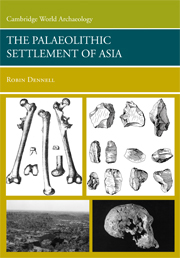Book contents
- Frontmatter
- Contents
- List of Tables, Figures, and Boxes
- Preface
- 1 Asia and Its Place in Palaeoanthropology
- 2 The African Background to the Colonisation of Asia
- 3 The Climatic and Environmental Background to Hominin Settlement in Asia before 1 MA
- 4 The Earliest Inhabitants of Southwest Asia
- 5 The Earliest Inhabitants of South and Southeast Asia and China
- 6 “Out of Africa 1” Reconsidered and the Earliest Colonisation of Asia
- 7 The Climatic and Environmental Background to Hominin Settlement in Asia between ca. 1 Ma and the Last Interglacial
- 8 The Middle Pleistocene Archaeological Record for Southwest and Central Asia
- 9 The Middle Pleistocene Archaeological Record of the Indian Subcontinent
- 10 The Middle Pleistocene Archaeological Record of China and Southeast Asia
- 11 Human Evolution in Asia during the Middle Pleistocene
- 12 Concluding Remarks
- Appendix 1 The Sizes of Countries and Regions in Asia, with Comparative Examples
- Appendix 2 Geographical Coordinates of Principal Early Palaeolithic Sites in Asia
- Appendix 3 Geographical Coordinates of Geological Sections and Cores
- Appendix 4 English Names of Various Mammals Recorded in Asia
- Bibliography
- Index
11 - Human Evolution in Asia during the Middle Pleistocene
Published online by Cambridge University Press: 05 June 2012
- Frontmatter
- Contents
- List of Tables, Figures, and Boxes
- Preface
- 1 Asia and Its Place in Palaeoanthropology
- 2 The African Background to the Colonisation of Asia
- 3 The Climatic and Environmental Background to Hominin Settlement in Asia before 1 MA
- 4 The Earliest Inhabitants of Southwest Asia
- 5 The Earliest Inhabitants of South and Southeast Asia and China
- 6 “Out of Africa 1” Reconsidered and the Earliest Colonisation of Asia
- 7 The Climatic and Environmental Background to Hominin Settlement in Asia between ca. 1 Ma and the Last Interglacial
- 8 The Middle Pleistocene Archaeological Record for Southwest and Central Asia
- 9 The Middle Pleistocene Archaeological Record of the Indian Subcontinent
- 10 The Middle Pleistocene Archaeological Record of China and Southeast Asia
- 11 Human Evolution in Asia during the Middle Pleistocene
- 12 Concluding Remarks
- Appendix 1 The Sizes of Countries and Regions in Asia, with Comparative Examples
- Appendix 2 Geographical Coordinates of Principal Early Palaeolithic Sites in Asia
- Appendix 3 Geographical Coordinates of Geological Sections and Cores
- Appendix 4 English Names of Various Mammals Recorded in Asia
- Bibliography
- Index
Summary
INTRODUCTION
The previous four chapters have reviewed the climatic and archaeological evidence from Middle Pleistocene Asia, but now it is time to consider the hominins behind the artefacts. Although well-dated and taxonomically informative Middle Pleistocene fossil specimens are sorely needed from inland Southwest, Central, South, and mainland Southeast Asia, there is sufficient evidence to allow a synthesis of Middle Pleistocene hominin evolution that takes account of the archaeological, faunal and climatic evidence now available. As argued in this chapter, this type of integrated approach allows a major rethinking of current views on the Asian Middle Pleistocene fossil hominin record. We can begin with the late Early Pleistocene background in Asia.
THE ASIAN MIDDLE PLEISTOCENE FOSSIL HOMININ RECORD
Throughout the Early Pleistocene, Homo erectus appears to have been the only type of hominin in Asia (Chapters 4–6). Opinions differ between lumpers and splitters as to whether this species also inhabited Africa, or whether its African counterpart was a different species, H. ergaster. In the Middle Pleistocene, this was no longer the case, and there may have been up to five types of Asian hominins: for certain, H. erectus sensu stricto, H. heidelbergensis, the ancestors of H. floresiensis, Neanderthals, and possibly also “archaic” H. sapiens. New types of hominins also appeared in both Europe and Africa. What happened between H. erectus and the emergence of modern humans is still very much “the muddle in the middle” of any narrative of human evolution.
- Type
- Chapter
- Information
- The Palaeolithic Settlement of Asia , pp. 438 - 472Publisher: Cambridge University PressPrint publication year: 2008



